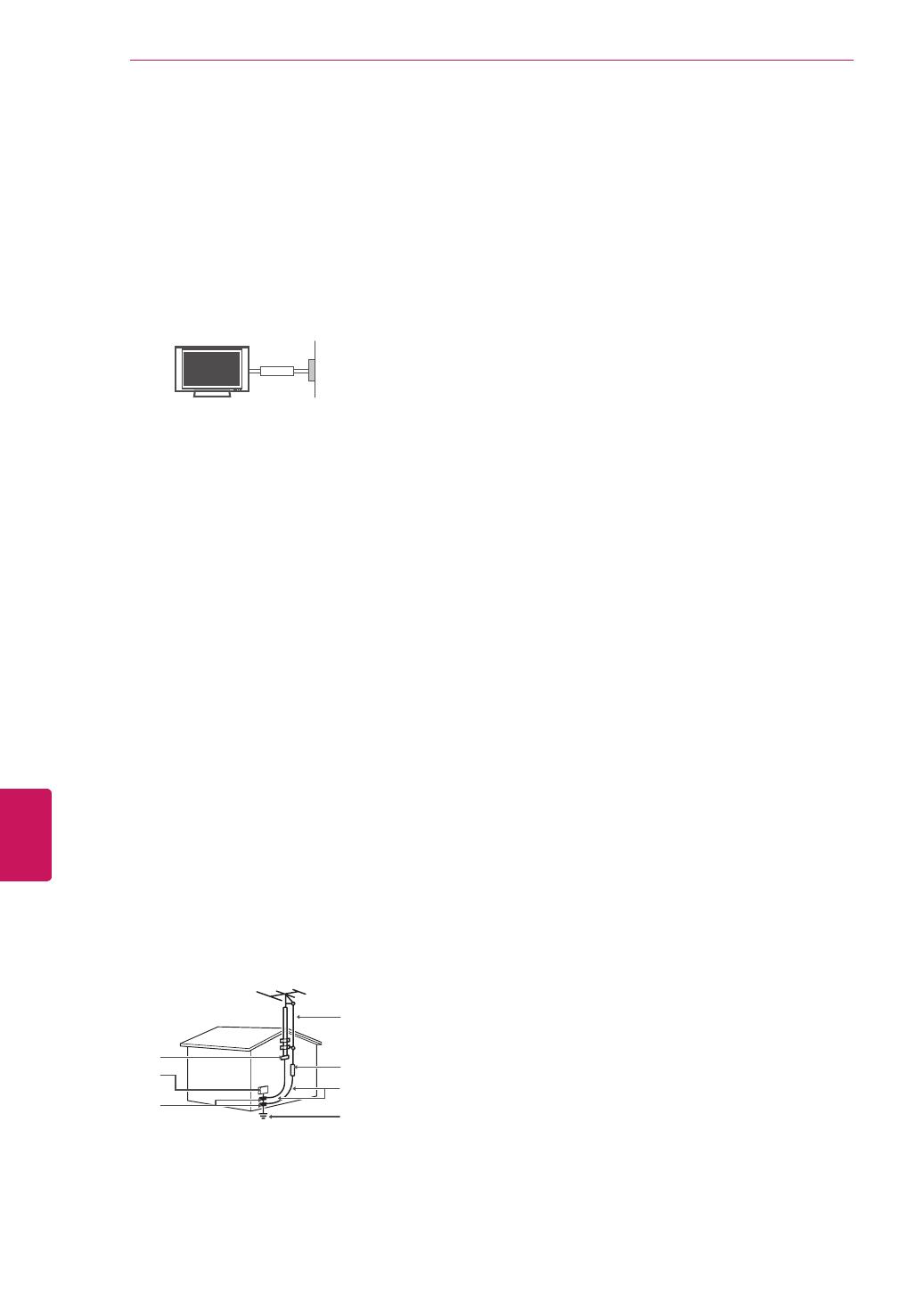
4
ENG
ESPAÑOL
INSTRUCCIONES DE SEGURIDAD IMPORTANTES
y
Puesta a tierra
(Excepto dispositivos sin conexión a tierra.)
Asegúrese de que el cable de puesta a tierra
esté conectado para evitar descargas eléctricas
(es decir, un televisor con un enchufe de CA de
tres clavijas debe conectarse a un tomacorriente
de CA con puesta a tierra de tres clavijas). Si no
puede colocarse ninguna puesta a tierra, solicite a
un electricista calificado que instale un disyuntor.
No intente improvisar una puesta a tierra con
conexiones a cables de teléfono, pararrayos o caños
de gas.
Short-circuit
Breaker
Power Supply
Alimentación
Interruptor
diferencial
y
Mientras la unidad esté conectada al tomacorriente
de CA de la pared, no se desconectará de la fuente
de alimentación de CA, aún cuando el aparato esté
apagado.
y
No intente modificar este producto de ninguna
manera sin autorización previa por escrito de LG
Electronics. Cualquier tipo de modificación sin
autorización previa podría anular la autoridad del
usuario para usar el producto.
y
Puesta a tierra con una antena exterior
(puede variar según el país):
Si instala una antena exterior, tome las siguientes
precauciones. No se debe instalar el sistema
de antena exterior cerca de las líneas aéreas de
transmisión de energía, de ningún circuito o luz
eléctrica, ni en ningún lugar donde pudiera entrar
en contacto con este tipo de cables eléctricos o
circuitos, dado que podría provocar daños graves
o incluso la muerte. Asegúrese de que el sistema
de antena tenga una puesta a tierra para proteger
contra sobretensiones y acumulaciones de cargas
estáticas. La Sección 810 del Código nacional de
electricidad (NEC) de los Estados Unidos establece
la forma de realizar una puesta a tierra correcta del
mástil, de la estructura de soporte, del cable de
bajada a una unidad de descarga de la antena, el
tamaño de los conductores de puesta a tierra, la
ubicación de la unidad de descarga de la antena,
y la conexión y los requisitos de los electrodos de
puesta a tierra
Puesta a tierra de la antena según el Código
nacional de electricidad, ANSI/NFPA 70
Short-circuit
Breaker
Power Supply
NEC: National Electrical Code
(Código nacional de electricidad)
Abrazadera de
puesta a tierra
Cable de entrada de la
antena
UNIDAD DE DESCARGA
DE LA ANTENA (NEC,
SECCIÓN 810-20)
Conductor de puesta a
tierra (NEC, Sección
810-21)
Sistema de electrodos
de conexión a tierra del
servicio de energía (NEC,
Artículo 250, Parte H)
Equipo de
servicio eléctrico
Abrazadera de
puesta a tierra
y
Limpieza
Al efectuar la limpieza, desenchufe el cable de
alimentación y limpie suavemente con un paño
suave para no rayar la superficie. No rocíe con agua
ni otros líquidos directamente sobre el televisor,
dado que podría provocar una descarga eléctrica.
No limpie con productos químicos como alcohol,
diluyentes o bencina.
y
Traslados
Asegúrese de que el aparato esté apagado,
desenchufado y que no quede ningún cable
conectado. Es posible que se necesiten dos
personas para trasladar los televisores de gran
tamaño. No ejerza presión ni empuje el panel frontal
del televisor.
y
Ventilación
Instale el televisor en un lugar bien ventilado. No lo
coloque en un lugar cerrado como, por ejemplo, un
estante para libros. No cubra el producto con telas
ni ningún otro material mientras esté enchufado. No
lo instale en lugares con demasiado polvo.
y
Si huele humo u otros olores que provienen de
la TV, desconecte el cable de alimentación y
comuníquese con un centro de servicio autorizado.
y
Mantenga el aparato alejado de la luz solar directa.
y
Nunca toque el aparato o la antena durante una
tormenta eléctrica o con truenos.
y
Al montar el televisor en la pared, asegúrese de que
los cables de alimentación y de señal no queden
colgando en la parte posterior.
y
No permita que se golpee el producto o que algún
objeto se caiga dentro de él, ni que se golpee la
pantalla.
y
Cómo desconectar la fuente de alimentación
principal
El tomacorriente utilizado con este dispositivo debe
ser de fácil acceso.
y
Guarde los accesorios (baterías, etc.) en un lugar
seguro lejos del alcance de los niños.
y
Este aparato usa baterías. Puede ser que en su
comunidad existan normativas que requieren que
deseche estas baterías de forma correcta debido
a las consideraciones ambientales. Póngase
en contacto con la autoridad local para obtener
información acerca del desecho o reciclaje.
y
No deseche las baterías en el fuego.
y
No provoque cortes de circuitos, desarme ni permita
que las baterías se recalienten























































































